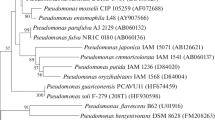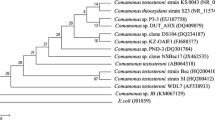Summary
A pseudomonad capable of using napthalene acetic acid as sole carbon source was isolated from soil. The route of decomposition proceeded through α-naphthol, salicyclic acid, and catechol. Similarities of this route to that for the breakdown of indole acetic acid are indicated.
Similar content being viewed by others
References
Booth, J. and Boyland, E., Metabolism of polycyclic compounds. 5 Formation of 1: 2 dihydroxy dihydronaphthalene Biochem. J.44, 361–365 (1949).
Dagley, S., Evans, W. C., and Ribbons, D. W., New pathways in the oxidative metabolism of aromatic compounds by micro-organisms. Nature188, 560–566 (1960).
Evans, W. C., Smith, B. S. W., Linstead, R. P., and Elvidge, J. A., Chemistry of the oxidative metabolism of certain aromatic compounds by micro organisms. Nature168, 772–775 (1951).
Evans, W. C., Oxidation of phenol and benzoic acid by some soil bacteria. Biochem. J.41, 373–382 (1947).
Jacobs, S. E., The influence of antiseptics on the bacterial and protozoal population of greenhouse soils. Pt. 1 Naphthalene. Ann. Applied Biol.18, 98 (1931).
Lees, H. and Quastel, J. H., Biochemistry of nitrification in soil. 1 Kinetics of and the effects of poisons on soil nitrification as studied by a soil perfusion technique. Biochem. J.40, 803–815 (1946).
Nickerson, W. J., Transformations of carbon compounds by micro-organisms. Ind. Eng. Chem.48, 1411 (1956).
Proctor, M. H., Bacterial dissimilation of indolacetic acid: a new route of breakdown of the indole nucleus. Nature181, 1345 (1958).
Society of American Bacteriologists, Manual of Methods for Pure Culture Study of Bacteria. Biotech. Publications, Geneva, N.Y. (1946).
Stanier, R. Y., Problems of bacterial oxidative metabolism. Bacteriol. Rev.14, 179 (1950).
Strawinsky, R. J. and Stone, R. W., Conditions governing the oxidation of naphthaelene and the chemical analysis of its products. J. Bacteriol.45, 16 (1943).
Strawinsky, R. J. and Stone, R. W., Biological oxidation of naphthalene. Can. J. Microbiol.1, 206 (1954).
Tausson, W. O., Naphthalin als Kohlenstoffquelle für Bakterien. Planta4, 214 (1927).
Thornton, H. E. and Gray, P. H. H., Soil bacteria that decompose certain aromatic compounds. Zentr. f. Bakteriol.73, 74 (1928).
Trecanni, V., Walker, N., and Wiltshire, G. H., The metabolism of naphthalene by soil bacteria. J. Gen. Microbiol.11, 341–348 (1954).
Walker, N. and Wiltshire, C. H., The breakdown of napthalene by a soil bacterium J. Gen. Microbiol.8, 273–276 (1953).
Walker, N. and Wiltshire, G. H., The decomposition of 1-chloro and 1-bromo naphthalene by soil bacteria. J. Gen. Microbiol.12, 478–483 (1955).
Young, L., The metabolic conversion of naphthalene to 1: 2 dihydronaphthalene-1:2 diol. Biochem. J.41, 417–422 (1947).
Author information
Authors and Affiliations
Rights and permissions
About this article
Cite this article
Proctor, M.H. Some steps in the degradation of naphthalene acetic acid. Plant Soil 18, 338–345 (1963). https://doi.org/10.1007/BF01347233
Received:
Issue Date:
DOI: https://doi.org/10.1007/BF01347233




